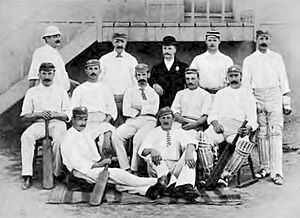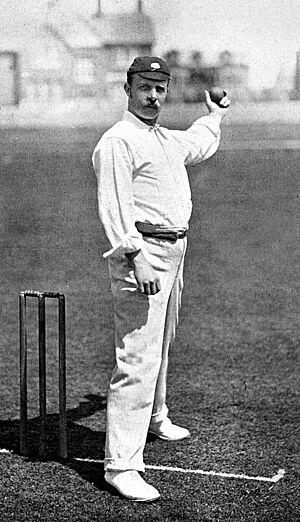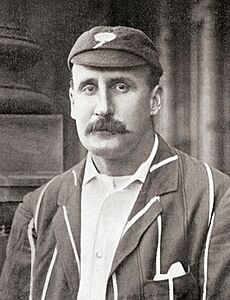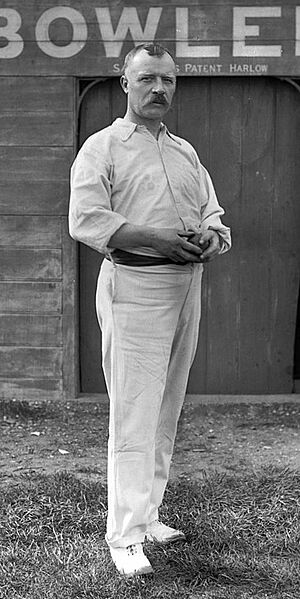Bobby Peel facts for kids
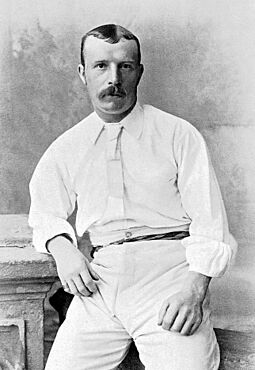
Bobby Peel c. 1895
|
||||||||||||||||||||||||||||||||||||||||
| Personal information | ||||||||||||||||||||||||||||||||||||||||
|---|---|---|---|---|---|---|---|---|---|---|---|---|---|---|---|---|---|---|---|---|---|---|---|---|---|---|---|---|---|---|---|---|---|---|---|---|---|---|---|---|
| Born | 12 February 1857 Churwell, Yorkshire, England |
|||||||||||||||||||||||||||||||||||||||
| Died | 12 August 1941 (aged 84) Morley, West Yorkshire, England |
|||||||||||||||||||||||||||||||||||||||
| Batting | Left-handed | |||||||||||||||||||||||||||||||||||||||
| Bowling | Slow left-arm orthodox | |||||||||||||||||||||||||||||||||||||||
| International information | ||||||||||||||||||||||||||||||||||||||||
| National side | ||||||||||||||||||||||||||||||||||||||||
| Test debut (cap 50) | 12 December 1884 v Australia | |||||||||||||||||||||||||||||||||||||||
| Last Test | 12 August 1896 v Australia | |||||||||||||||||||||||||||||||||||||||
| Domestic team information | ||||||||||||||||||||||||||||||||||||||||
| Years | Team | |||||||||||||||||||||||||||||||||||||||
| 1883–1897 | Yorkshire | |||||||||||||||||||||||||||||||||||||||
| Career statistics | ||||||||||||||||||||||||||||||||||||||||
|
||||||||||||||||||||||||||||||||||||||||
|
Source: Cricinfo, 8 January 2014
|
||||||||||||||||||||||||||||||||||||||||
Robert "Bobby" Peel (born February 12, 1857 – died August 12, 1941) was a famous English professional cricket player. He played for the Yorkshire team from 1883 to 1897. Bobby was mainly a left-arm spin bowler, which means he bowled with a spinning motion using his left arm. He was also a good left-handed batsman who usually batted in the middle of the team's batting order.
From 1884 to 1896, Bobby Peel often played for the England national team. He played in 20 Test matches and took 101 wickets. Throughout his whole career, he scored 12,191 runs and took 1,775 wickets in first-class cricket. He was known as a bowler who could win matches, especially when the weather and pitch conditions helped his bowling style. Critics thought very highly of him.
Contents
Bobby Peel's Early Cricket Days
Becoming a Yorkshire Player
Bobby Peel was born in Churwell, a village near Morley, on February 12, 1857. His father was a miner, and Bobby also worked in the mines for a while. From age 16, he played cricket more and more for his local Churwell team. By 1882, he was part of the Yorkshire Colts team, which was a step towards playing for the main county team.
At that time, another left-arm spin bowler named Edmund Peate was the main choice for the Yorkshire team. This limited Bobby's chances to play. However, an injury to Peate allowed Bobby to play his first major game for Yorkshire. This was a "first-class" match against Surrey in Sheffield on July 10, 1882. Bobby did very well, taking nine wickets in the game. This included taking five wickets while only giving away 83 runs in one part of the match. Lord Hawke, who later became Yorkshire's captain, said Bobby's first game was one of the most impressive for Yorkshire.
Between 1883 and 1886, Bobby often played alongside Peate. He had a smaller role and didn't bowl as much. He took 163 wickets for Yorkshire during these five seasons. He only took more than 50 wickets in a season once before 1887. Bobby kept his place in the team because he was also a good batsman and a great fielder. He was described as "brilliant" at fielding. His batting also got better, which helped him stay in the county team.
Playing for England: His First Test Matches
In the winter of 1884–85, Bobby Peel was chosen to join an English team touring Australia. At this time, English teams touring Australia were not always made up of the very best players. This tour's team had nine players who were considered top-level. Many of the games were affected by arguments off the field about money.
Bobby had to bowl many "overs" (a set of six balls bowled by one player). In smaller games, he took 321 wickets. In the more important "first-class" matches, he took the most wickets with 35.
During this tour, Bobby made his Test match debut, playing in all five matches. His first Test began on December 12, 1884. He started the bowling attack and took eight wickets in the match. In the second part of the game, he took five wickets for 51 runs on a pitch that was wet from rain. He was not as effective in the other games. He finished the series with 21 wickets and scored 37 runs. He was not picked for the next Test matches against Australia in 1886.
Becoming a Leading Bowler
Taking the Lead for Yorkshire
In the mid-1880s, the Yorkshire team was not playing very consistently. In 1886, Lord Hawke became Yorkshire's full-time captain. One of his first big decisions was to remove Edmund Peate from the team in 1887. Peate had caused problems for a few years. He was a good bowler, but his behavior was affecting the team. Lord Hawke likely felt he could make this change because Bobby Peel was ready to take Peate's place.
With Peate gone, Bobby Peel became Yorkshire's main bowler. In the 1887 season, which had good weather for batsmen, Bobby took 85 wickets. He also improved his batting, scoring 835 runs. He had at least two match-winning performances that season. Against Kent, he took five wickets for 14 runs and scored 43 runs in a game where not many runs were scored. Against Leicestershire, he took eleven wickets for 51 runs. In 1887, Bobby also played for the professional "Players" team in their important match against the "Gentlemen" (amateur players). He played for the Players team regularly until 1897.
In the winter of 1887–88, another English team toured Australia. Bobby Peel was one of the few professional players included. At the same time, a rival English team also toured Australia. This caused confusion and affected how many people came to watch the games. Bobby took 49 wickets in first-class matches on the tour. He also scored 449 runs, which was the second-highest for his team. Only one official Test match was played on this tour. Bobby took nine wickets in that game, including five wickets for 18 runs in the first part of the match. Australia was bowled out for only 42 runs.
Playing Test Matches in England
In 1888, it was a very rainy summer, which made the cricket pitches wet and difficult for batsmen. Bobby Peel took 171 first-class wickets that year. This was the first time he had taken over 100 wickets in a season. He also had the best bowling average for Yorkshire in county matches. His best performance was against Nottinghamshire, where he took eight wickets for 12 runs in one part of the game. He ended up with fourteen wickets for 33 runs in the whole match.
That year, an Australian team visited England, and Bobby Peel was chosen to play in his first Test matches in England. The Australian team won the first Test, but England won the next two. Bobby played in all three Tests and took 24 wickets. In the final Test, he took seven wickets for 31 runs in Australia's first innings. He finished with eleven wickets for 68 runs in the match. Wisden, a famous cricket book, said that Bobby "bowled remarkably well" and that the Australians "were helpless against Peel."
Because of his great performance in 1888, Bobby Peel was named one of Wisden's "Six Great Bowlers" before the 1889 season. This award later became the important Wisden Cricketer of the Year award. The award said that Bobby had worked his way to the top because of his skill. It also noted that he batted and fielded so well that he would be valuable to any team, even if he didn't take wickets.
Yorkshire had a tough season in 1889, finishing near the bottom of the county list. The team lost many games. Only Bobby Peel had a good season. He took 130 wickets and scored 991 runs, which was his best batting total at that time. He was the best in both batting and bowling for Yorkshire. He also scored his first "century" (100 runs or more) in a first-class match, scoring 158 runs against Middlesex. At the end of the season, Lord Hawke removed several players from the team.
In 1890, Bobby Peel took 171 wickets and scored 817 runs. He was by far Yorkshire's leading bowler. The Australians toured England again that year. Bobby took six wickets in the first Test match. However, the Australian team was not playing well, which made the Test matches less exciting. The new County Championship was also popular. Some players were pulled out of the England team to play for their counties. Lord Hawke also pulled his Yorkshire players, including Bobby, from the England team for the second Test. The third Test was completely rained off.
In 1891, Bobby Peel took 99 wickets and scored 971 runs, including his second first-class century. Yorkshire still didn't perform well, which led to changes in the club. In the winter of 1891–92, Bobby went on another tour to Australia. He took 15 wickets and scored 229 runs. He played in all three Test matches, taking six wickets and scoring 134 runs. In the third game, he scored 83 runs, his first Test match "fifty" (50 runs or more).
In 1892, Bobby scored 772 runs and took 121 wickets. In 1893, he took 126 wickets but scored fewer runs. Yorkshire had a successful year, winning their first official County Championship title. The team was not as dependent on Bobby's bowling anymore. The Australians toured England again, but Bobby only played in one of the three Test matches. He didn't take a wicket and was left out of the team for the second Test. Lord Hawke pulled Bobby and another player from the third Test so they could play for Yorkshire. In 1894, Bobby scored 699 runs and took 145 wickets. He was given a "benefit match" in Bradford, which raised £2,000 for him. He became the team's senior professional player.
The Australian Tour of 1894–95
In 1894, Bobby Peel was chosen for another English tour to Australia. He did well in the first matches of the tour. He took five wickets in an innings against several Australian teams. After three games, he had taken 23 wickets. He also scored 48 and 65 runs in one match.
He played a big part in the first Test match, which was described as "probably the most sensational match ever played." Australia scored a huge 586 runs in their first turn at batting. England scored 325 and then had to bat again. They scored 437, leaving Australia needing 177 runs to win. At the end of the fifth day, Australia had scored 113 for two wickets, and everyone thought they would win easily.
Until then, Bobby had not done well in the match. Many of the England team thought the game was lost. But overnight rain completely changed the pitch. The start of play was delayed, which allowed the pitch to dry and become very "sticky" and hard to bat on. Bobby and another bowler, Johnny Briggs, bowled Australia out. Bobby took five wickets that day, adding to the one he took the evening before, to finish with six wickets for 67 runs. Australia scored 166 and lost by ten runs. The English team was praised for their comeback, but people also knew the weather played a big part.
England won the second Test. Bobby, batting at number six, scored 53 runs without hitting any "fours" (balls that reach the boundary). England set Australia a big target, and Bobby took four wickets to help England win. Australia won the third Test, and Bobby took four wickets but scored no runs in either of his turns at batting. Australia won the fourth Test to make the series tied at 2-2. Bobby took three wickets, but Australia still scored many runs. England was bowled out twice, and Bobby scored no runs in either of his turns again. He was the first player to score four "ducks" (no runs) in a row in Test cricket.
The final Test match was very exciting. Bobby took four wickets in Australia's first turn. Then he scored 73 runs in England's first turn, sharing a big partnership of 162 runs with Archie MacLaren. In Australia's second turn, Bobby took three more wickets. Jack Brown scored a century to help England chase down 297 runs, and Bobby eventually hit the winning runs. Bobby finished the series with 27 wickets and 168 runs. This series was very important in making Test cricket popular.
Final Seasons
Back in England for the 1895 season, Bobby Peel took 180 wickets, which was the most he took in any season. This included his best ever bowling figures: nine wickets for 22 runs against Somerset. He took fifteen wickets in that match, which Wisden said "caused a sensation." He was the top bowler for Yorkshire, and George Hirst became his regular bowling partner. They formed a very effective team until Bobby's career ended. In 1895, Bobby also scored 847 runs.
In 1896, Bobby Peel achieved the "double" for the only time in his career. This means he scored over 1,000 runs and took over 100 wickets in the same first-class season. He took 128 wickets and scored 1,206 runs, which was his best batting total and average in an English season. He often scored runs when his team was struggling. Against Warwickshire, he scored 210 runs without being out. This was his highest score in a first-class game. He also shared a huge partnership of 292 runs with Lord Hawke. This is still Yorkshire's highest partnership for that wicket. He also took a "hat-trick" (three wickets in three balls) against Kent.
The Australians played three Tests in England in 1896. Bobby only played in the final one. Before the third day of the game, the pitch was mysteriously watered, making it very hard to bat on. Australia only needed a small number of runs to win, but Bobby believed he could bowl them out. He took six of the last seven Australian wickets for only 23 runs, helping England win. As a thank you, his teammate Stanley Jackson gave him a gold watch-chain ornament. This was Bobby's final Test match. In total, Bobby played 20 Tests, scoring 427 runs and taking 101 wickets.
In January 1897, an Australian bowler named Fred Spofforth claimed that Bobby Peel sometimes "threw" the ball, which is against the rules in cricket. Bobby denied this and said that umpires would support him.
Leaving Yorkshire
In the 1897 season, Bobby Peel was suspended by Yorkshire.
Bobby had been playing regularly and successfully until July 1897. He scored 115 runs against Leicestershire and took eight wickets for 53 runs against Kent. He then got injured and missed about a month of cricket. He returned to the Yorkshire team to play Middlesex on August 16. In Middlesex's first turn at batting, Bobby took five wickets for 71 runs. However, on the third day, he was not in a fit state to play. Later that day, the Yorkshire committee decided to suspend Bobby for the rest of the season.
Bobby felt that the suspension would end his career with Yorkshire, so he signed a contract to play for Accrington Cricket Club. He told a newspaper that he thought his suspension was unfair and that he wasn't given a chance to explain. He said he took the Accrington job to support his family. He later said that Lord Hawke "put his arm around me and escorted me off the field and out of Yorkshire cricket. What a gentleman." Lord Hawke later said that removing Bobby was "the most decisive action of my whole career." He felt it had to be done for the team's discipline. Although Bobby thought he was essential, the next year he was replaced by Wilfred Rhodes, who played for Yorkshire until 1930 and took many wickets. Bobby remained popular with the people of Morley.
Later Life and Legacy
Bobby Peel played two more first-class matches in 1897 after his suspension. He played in two end-of-season games but didn't do much with bat or ball. In all first-class games that year, he took 72 wickets and scored 566 runs. His only other first-class appearances were in 1899. He finished his first-class career with 12,191 runs and 1,775 wickets.
In 1898, Bobby played for Accrington. He was one of the first international cricketers to play in a league. He took 80 wickets that season. His contract was not renewed, and he became a professional player at Morley. Bobby also became a coach at Essex in 1899 and stayed there for several years. He later became the owner of a public house in Churwell. In 1923, he started working with Yorkshire again, coaching and finding new talent with George Hirst.
Bobby stayed close to the Yorkshire players. When four Yorkshire players left for a tour of Australia in 1932–33, Bobby was there and gave each of them a white rose, the symbol of Yorkshire. He continued to play cricket and coach locally even into his seventies. In his later years, he worked in a woollen mill in Morley.
Bobby Peel was married in 1878 to Annie Louise. They were married for over fifty years and had four children. One of their children was killed in the First World War. Bobby's wife died in 1933. Bobby lived until 1941, when he died at his daughter's house at the age of 84. George Hirst and Wilfred Rhodes were among those who attended his funeral.
How Bobby Peel Played
Wisden said that Bobby Peel was a bowler who could "win matches." He bowled with great control and varied how the ball flew through the air to trick batsmen. He also bowled a faster ball that went straight instead of turning. On wet pitches, batsmen found him very hard to face, and he was very successful in these conditions. When the ball came off the pitch more slowly, Bobby often bowled faster. This made it hard for batsmen to score runs against him. He usually started the bowling attack for his team, even for England. At that time, it was common to start with a fast bowler and a left-arm spinner.
Bobby Peel was the first English bowler to take 100 Test wickets against Australia. Playing 20 Test matches was a big achievement back then, as international games were rare. He also toured Australia four times, which was unusual. His main rival as a spinner was Johnny Briggs. Bobby bowled faster, which made him harder to hit. Archie MacLaren, who captained England, called Bobby "the cleverest bowler of my time." MacLaren said Bobby understood tactics well and could find weaknesses in a batsman's technique. He believed Bobby was the best left-handed bowler because of his amazing judgment and skill. Historians see Bobby Peel as part of a long line of successful Yorkshire left-arm spinners, following Edmund Peate and before Wilfred Rhodes.
Wisden described Bobby Peel as a "punishing left-handed batsman." Batting in the middle of the order, he often did well when other batsmen had failed. For England, he usually batted at number six. Wisden also called him a "capital fieldsman," especially at a position called "cover-point."
During his playing days, Bobby Peel was famous and well-respected. The actor Henry Ainley once said that carrying Bobby's cricket bag was a highlight of his life.
Images for kids


